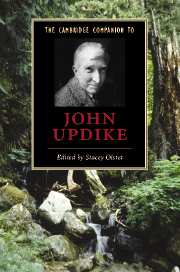Book contents
- Frontmatter
- Introduction: “A sort of helplessly 50’s guy”
- Part I Early influences and recurrent concerns
- Part II Controversy and difference
- Part III American chronicles
- 7 Updike, American history, and historical methodology
- 8 Updike, Hawthorne, and American literary history
- 9 Updike, film, and American popular culture
- 10 Updike, Rabbit, and the myth of American exceptionalism
- Conclusion: U(pdike) & P(ostmodernism)
- Select bibliography
- Index
10 - Updike, Rabbit, and the myth of American exceptionalism
from Part III - American chronicles
Published online by Cambridge University Press: 28 August 2006
- Frontmatter
- Introduction: “A sort of helplessly 50’s guy”
- Part I Early influences and recurrent concerns
- Part II Controversy and difference
- Part III American chronicles
- 7 Updike, American history, and historical methodology
- 8 Updike, Hawthorne, and American literary history
- 9 Updike, film, and American popular culture
- 10 Updike, Rabbit, and the myth of American exceptionalism
- Conclusion: U(pdike) & P(ostmodernism)
- Select bibliography
- Index
Summary
He had thought . . . that from shore to shore all America was the same.
– Rabbit, Run (1960)America is a vast conspiracy to make you happy.
– “How to Love America and Leave It at the Same Time” (1972)the American way . . .
– “Americana” (2001)[M]y only duty was to describe reality as it had come to me – to give the mundane its beautiful due.
– Foreword, The Early Stories, 1953–1975 (2003)When, at the beginning of his career, John Updike published the first, preliminary characterizations of Rabbit Angstrom - the short story “Ace in the Hole” (1955; Same, 14-26) and the poem “Ex-Basketball Player” (1957; Carpentered, 2-3) - he did not know that he was committing himself to a long meditation on America. The meditation has lasted a lifetime. At its center sit the four novels that trace Rabbit Angstrom's anguished run, but surrounding this core and giving it resonance are the tales and essays in which Updike probes the national character, seeking to define America itself. The definition has changed during the course of his distinguished career. Rather than a straight line toward confirmation of an ideal, it is a receding curve toward questioning of a once-assured certainty.
Updike’s United States is predominantly a culture of the middle class, but this does not mean that the “middle” or his sense of America remains static. To the consternation of his negative – usually ideologically committed – critics, he prefers posing problems to preaching answers. Read as a whole, his canon reveals a changing, darkening, increasingly skeptical view of Americanness: the middle is still beautiful, as he once argued in “The Dogwood Tree: A Boyhood” (1962; Assorted, 151–187), but the quest for happiness is today more problematical, more tenuous. Like most great authors, he is under no obligation to be consistent in either the perspective toward his subject matter or the technique used to express it. His short stories frame the curve that the Rabbit novels illustrate.
- Type
- Chapter
- Information
- The Cambridge Companion to John Updike , pp. 149 - 161Publisher: Cambridge University PressPrint publication year: 2006
- 1
- Cited by



